
REPRODUCTION
Concept of Reproduction
Reproduction is the ability of living organisms to form new individuals of the same species from those already in existence. Here, the new organisms replace those that have died and so life continues. It can also be defined as the process whereby organisms produce new individuals of the same species. It is one of the important features of living things.
The Merits and Demerits of Sexual and Asexual Reproduction
Explain the merits and demerits of sexual and asexual reproduction
Sexual Reproduction
This is a type of reproduction in which new organism is produced when a male gamete fuses with a female gamete. Sexual reproduction involves the fusion of two gametes. The process of fusion of gametes is called fertilization.
These two gametes differ in form and function and each is produced from a different organ. In animals the gametes producing organs are called gonads. These include the ovaries and testes. In flowering plant structures concerned with the production of gametes are the ovaries and anthers. The testes and anthers produce the male gametes while ovaries produce the female gametes.
Merits of Sexual Reproduction
- It ensures genetic stability
- It ensures perpetuation of life
- It brings variation
- Leads to the interaction among organisms
Demerits of Sexual Reproduction
- Offspring have a great chance of inheriting diseases from the parent
- The reproduction takes long time
- It needs energy
- The sexual reproduction produces few numbers of offspring
- It depends on presences of two parents
- It leads to great chance of spreading diseases
- It takes a long time until offspring are produced
Asexual Reproduction
This is the type of reproduction whereby production of offspring is from single organism without the production of gametes. There is no fusion of gametes.
Examples of organisms who produce asexually are amoeba and bacteria. Asexual reproduction involves only one individual organism. That means no change of genetic material is passed from a parent to an offspring. The offspring are also identical to their parents.
In this kind of reproduction, in same organisms, body part such as roots, stems or leaves may become reproductive body organs.
Depending on the type of organisms asexual reproduction may be of different forms or ways such as:
- Fission
- Sporulation/Spore formation
- Budding
- Fragmentation
- Vegetative propagation
- Binnary Fission (Splitting)
- Suckers
- Bulbils
Binary Fission (Splitting)
This is an asexual reproduction in which an organism divides into two equal parts, which are identical to each other.
Each part then grows to attain the original size of the parent cell and hence become a separate and independent organism.
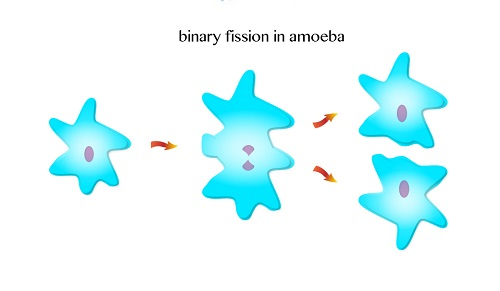
Fragmentation
This is a form of asexual reproduction in which organisms (parent) breaks into two or more parts. Fragments grow and develop into a new organism with identical features as the parent. Example worms such as Nematodes and flat worms.
Sporulation/Spore formation
Sporulation is asexual reproduction by the use of spores. The spore develops from single cell as a result of mitosis, forming a structure known as sporangium. When the sporangium is truly developed, the wall bursts to release the spores which when placed in suitable area they germinate into new organisms.
Other organisms, which reproduce by sporulation, are ferns and mosses.
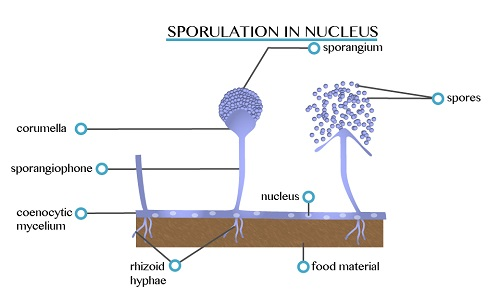
Budding
Budding is a type of asexual reproduction in which a new organism arises as an outgrowth (bud) of the older organism (parent). The bud later separates from the parent and grows to become an independent organism to attain the size of the parent. Examples: yeast and hydra

Some flowering plants reproduce through the formation of structure called buds. Roots may form such buds, leaves or underground stems and such buds sprout to form new independent plants.
Vegetative propagation
Vegetative propagation is a form of asexual reproduction found in plants in which a bud grows and develops into a new plant. The detached plant, root, stem or leaves at some stages grows and develops into an independent plant.
Artificial vegetables propagation: This is vegetative propagation, which occurs through man’s manipulation. Man can learn from plants’ natural vegetative propagation and can intervene and make propagation of plants artificially.
Natural vegetative propagation: Vegetative propagation involves different parts of plants as discussed below. Such as:
Bulb
In this type each bud grows to form a shoot, which produces a new bulb at the end of the growing season.
Bulb is a modified underground shoot having fresh strong leaves
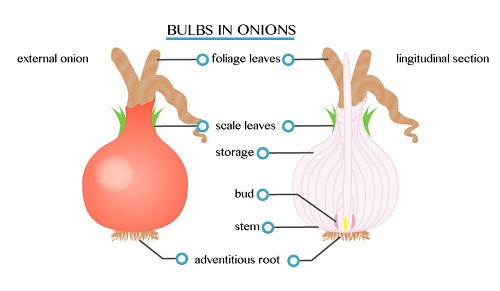
Tubers
These are short swollen underground storage organs formed from a stem or a root. New tubers are made at the end of the growing season but do not arise from old tubers.
Stem tubers
These are short swollen underground stems, which store food, such as starch. Normally, yam plants form a number of tubers each of which can rise to a new plant. Such new plant continues to live after the death of the parent.
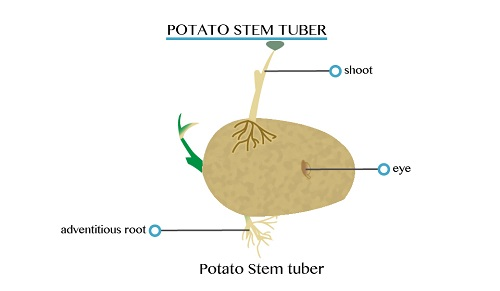
Root tubers
These are swollen adventitious underground roots. Roots tubers such as sweet potatoes and cassava store their food in root tubers and do not bear leaves or bud.
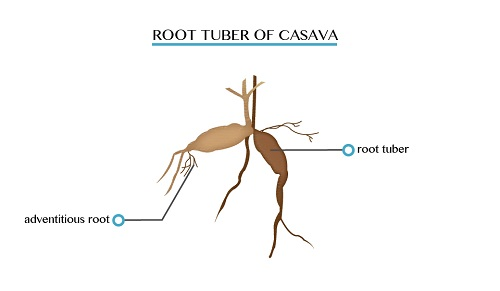
Rhizomes
These are horizontally growing underground stems, bearing leaves, buds and adventitious roots. Examples are lilies, ferns and grass.
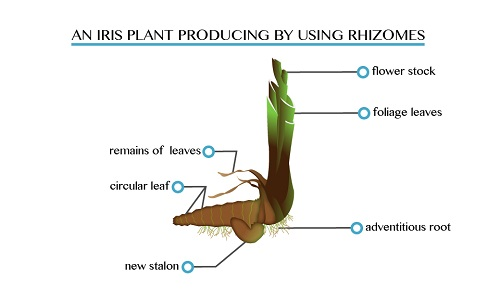
Stolons
These are slender stems, creeping horizontally as they grow along the ground surface. Examples: strawberries, black currant and oxalis.

Suckers
These are short horizontal branches, arising from the main stem or just below ground level. Suckers contain food reserves. Examples: Bananas, sisal and pineapples
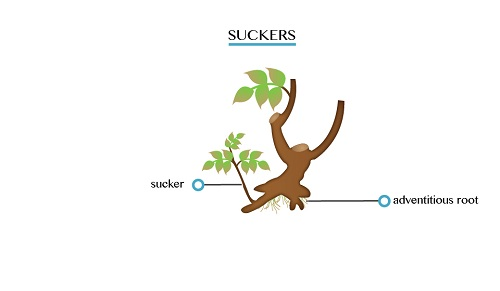
Tap root
A taproot is the main root that arises from a radical. Tap roots may become swollen and act as storage organs.
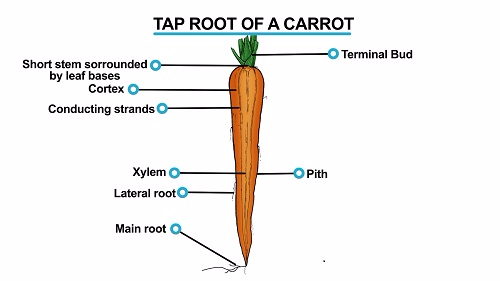
Tillers
These are collection of shoots. Grass plants consist of a number of tillers. Each tiller has a number of leaves, which arise from the stem of nodes at the base of the leaves.
Leaves
Some plants such as cactus propagate vegetative using leaves. When the leaves fall off from a plant they develop adventitious roots and buds, which later may grow and develop into mature plants.
Merits of Asexual Reproduction
- Asexual reproduction results into an individual with the same genetic constitution as their parent.
- Its offspring matures faster than sexually reproduced organisms
- It does not depend on processes of pollination, seed or fruit dispersal
Demerits of Asexual Reproduction
- Asexually reproducing organisms are at a great risk to perish or get destructed when environmental conditions are unfavorable
- The parents may pass undesirable characteristics to the offspring since only one individual organism is involved in asexual reproduction
- Competition for resources such as food and shelter may occur due to large number of organisms being produced
Meiosis and Reproduction
The Meaning of Meiosis
Give the meaning of meiosis
Reproduction involves the transmission of genetic materials from one generation to the next insuring that species survive. The process of reproduction involves meiosis.
Meiosis is the type of cell division, which occurs in the reproductive organs to produce sex cells known as gametes.
In this type of cell division the parent cells has diploid number of chromosomes. However the daughter cell arising from the cell division has the half number of chromosomes a condition known as haploid state.
Therefore meiosis reduces the chromosomes number into half means from 2n to n.
The Significance of Meiosis in Relation to Reproduction
Explain the significance of meiosis in relation to reproduction
Meiosis leads to the formation of reproductive cells (Gametes) such as ova and sperms each with half number of chromosomes of the parent cells in organisms reproducing through sexual reproduction.
It involves the possibility of exchange of pieces of genetic information between the paternal and maternal chromosomes of each pair leading to new combination of characteristics in the gametes.
It brings about variation when the members of each pair of chromosomes are separated from each other independently (Random assortment)
Meiosis leads to new combination of genes through the process of independent assortment of chromosomes occurring during meiosis I
Meiosis involves number of processes from prophase, metaphase, anaphase and telephase. There are two meiotic divisions, the first and the second division. All the above named processes occur in both the first meiotic division and the second meiotic division.
First Meiotic Division
The first division of meiosis consists of:
- Prophase I
- Metaphase I
- Anaphase I
- Telophase I
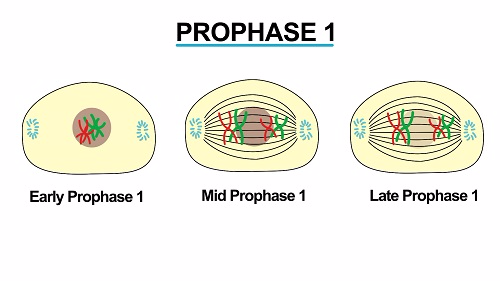
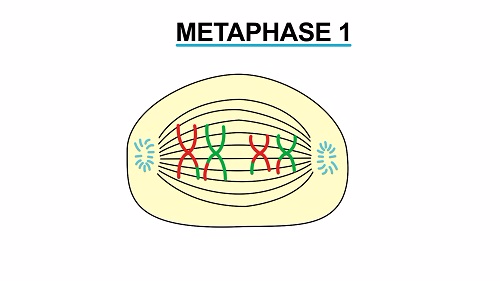
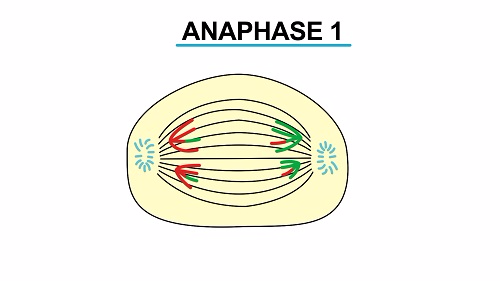
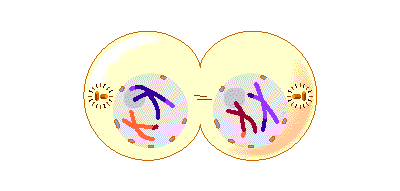
Telophase I
Prophase I
During prophase I the following events occur.
- The nucleus disappears and the centrioles if present migrate to the poles
- Chromosomes condenses and the spindle is formed
- As prophase proceed homologous chromosomes come to lie side by side and there after become intertwined by the process called synapsis
Through synapsis homologous chromosomes is referred to as crossing over. The point at which homologous chromosomes exchange genetic materials is known as chiasmata
Early Prophase I
The following events occur during early prophase:
- Chromosomes contract, thickening, shortening and become more visible
- Nucleus disintegrate and disappear
Mid Prophase I
- Homologous chromosomes come together (synapses) forming a bivalent
Late Prophase I
- Chromatids cross over by chiasmata which results into exchange of genetic materials
Metaphase I
- Bivalent homologous chromosomes moves to the equator of the spindle
Anaphase I
- The two homologous chromosomes part company and migrate to opposite poles of the spindle
- The centromeres of the homologous pairs migrate towards the opposite poles where they are attracted.
Telophase
- The chromosomes reach their destination
- The spindle apparatuses breaks down and disintegrates
- Then the nucleus membrane reforms around each set of chromosomes
- The cell constricts across the membrane and divides into two
Telephase I make the end of the first meiotic division.
- At the end of this prophase the number of chromosomes in each cell is half the chromosomes number cell.
- This is the reason why first meiotic division is referred to as Reduction division
Second meiotic division
Prophase II
Centrioles replicates and a new spindle apparatuses formed
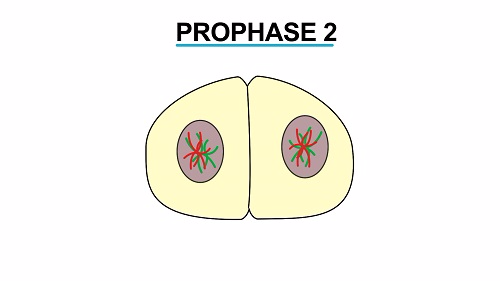
Metaphase II
Chromosomes migrate to the equator f the spindle
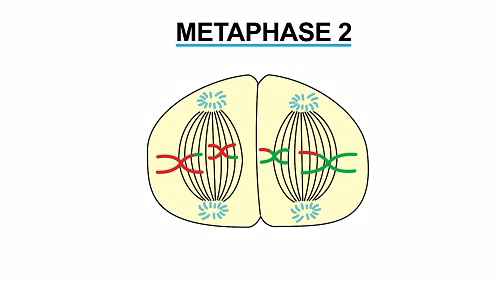
Anaphase II
- Sister chromatids part company and migrate to opposite poles of the cell
Telophase II
- The spindle apparatuses disappears
- The nucleus repairs and a new nucleus membrane is formed around each set of chromatids
- The chromatids uncoil and the cell divides into two
- Chromosomes regain their thread like structure and the cell enter interphase. Meiosis results into the formation of four daughter cells each with haploid set of chromosomes
- It should be stressed that the four daughter cells formed has the half number of chromosomes present in the original parent cell.
Experiments to Show Stages of Meiosis Process
Carry out experiments to show stages of meiosis process
Meiosis Vedeo
Reproduction in Flowering Plants, the structure of the Flower
Some plants use flowers to reproduce. The flowers contain all the parts needed for the reproduction process. Sexual reproduction in flowering plants takes place in the flower. Within a flower, there are usually structures that produce both male gametes and female gametes.
The Structure of the Flower
Describe the structure of the flower
A flowering plant is an angiosperm, which is any plant that produces a flower or fruit. The sole purpose of the flower is to allow the plant to reproduce. Each part of the flower plays a role in the steps of reproduction. There are male gametes and female gametes. They are both directly involved with sexual reproduction. Pollen may spread from plant to plant but can only reproduce with the same species of plants. Let's take a look at the different parts of the flower.
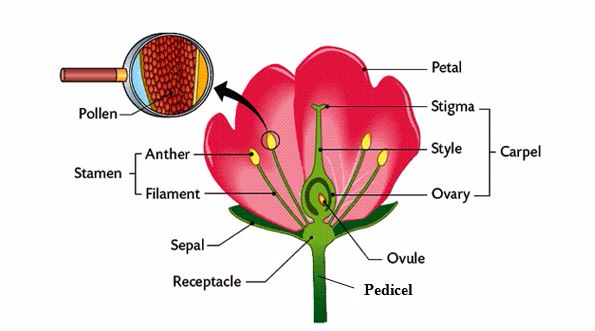
Structure of a flower
STERILE PARTS
Let's start with the sterile parts of the flower, or those parts that are neither male nor female. These sterile parts are not directly involved in the fertilization process. Technically, a flowering plant can reproduce without them; however, they do play important roles in helping with reproduction.
- Pedicel:The pedicel is a small stalk or stalk-like part bearing a single flower in an inflorescence. The Some flowers have no stalk and are directly attached to the stem of the plant.
- Receptacle:The receptacle is the place on the stem where floral organs originate and attach.It is the axis (stem) to which the floral organs are attached. In most angiosperms, floral organs are attached in alternating successive whorls. A whorl is an arrangement of sepals, petals, leaves, stipules or branches that radiate from a single point and surround or wrap around the stem.
- Sepals:Sepals are the parts that look like little leaves that cover the flower before it blooms. They cup the flower to protect it while it grows. Sepals are mostly green and in most flowers they resemble leaves. A flower bud is protected by sepals. Collectively, all of the sepals form the calyx.Sepals may be hairy, for example in roses, or smooth, for example in hibiscus.Some flowers have sepal-like structures beneath the calyx known as epicalyx, for example the hibiscus flower.
- Petals:Petals are the delicate and usually brightly coloured part that gives the flower its character. Flowers have more than one petal, and the flower petals are collectively called the corolla. The colour and scent attracts the agents of pollination such as birds and insects. Fused petals form a corolla that can be tubular or funnel-shaped as in the flowers of sweet potato and pumpkin plants. Some of the petals of leguminous plants are keel-like and they enclose stamens and carpels.Sepals and petals are collectively referred to as the perianth.
Reproductive Parts of the Flower
Identify reproductive parts of the flower
The flower is the reproductive unit of some plants (angiosperms). Parts of the flower include petals, sepals, one or more carpels (the female reproductive organs), and stamens (the male reproductive organs).
The female reproductive organs
The pistil is the collective term for the carpel(s). A carpel is actually three parts fused into one: stigma, style, and ovary. The stigma is at the top of the flower. It is sticky to catch the pollen. Each carpel includes an ovary (where the ovules are produced; ovules are the female reproductive cells, the eggs), a style (a tube on top of the ovary), and a stigma (which receives the pollen during fertilization).
The ovary is at the base of the flower. From the ovary, extends a tubular structure called the style and on the top of the style is a surface receptive to pollen called the stigma. The stigma can take many different forms, most of them designed to help trap pollen.
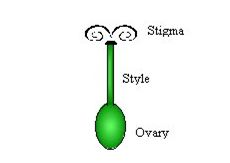
Female parts of a flower
The female parts of the flower are discussed in detail below:
- Ovary:The ovary contains ovules. Ovules are unfertilized female gametes. The position of the ovary in relation to the receptacle varies from one flower to another. The ovary could be either superior or inferior in relation to the position of the receptacle. A superior ovary is one that is positioned above the receptacle, for example the ovary of a bean flower. An inferior ovary is one that is positioned below or enclosed within the receptacle. Examples are the ovaries of a rose and a black jack flower.
- Style:The style is a long tube that attaches the stigma to the ovary. The length of the style varies from one flower to another. This length determines the position of the stigma. In the maize plants, the style and the stigma hand outside the flower.
- Stigma:The stigma is a glandular sticky structure at the tip of the carpel. The stigma is the tissue into which the pollen grains are deposited. The branches of the stigma correspond to the number of carpels. Five branches of the stigma indicate the presence of five carpels.
The male reproductive organs
The male parts of a flower consist of one or more stamens. Stamens are the male reproductive parts of flowers. A stamen consists of an anther (which produces pollen) and a filament. The pollen consists of the male reproductive cells; they fertilize ovules.
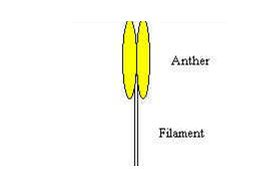
Male parts of a flower
The following is a detailed description of the female parts of the flower.
- Filament:The filament is a slender stalk that supports the anther. The filament may arise from the receptacle or the petals. It supports the anther.
- Anther:The anther is attached to the apex of the filament. It produces the pollen grains that contain the sperm needed for fertilization.
Types of flowers
Flowers are classified either as complete or incomplete. Complete flowers have sepals, petals stamens and carpels. A flower with both stamens and carpel is said to be bisexual. The hibiscus flower is bisexual.
Incomplete flowers lack some of the floral parts. Flowers that have carpels only are referred to as pistillate flowers. Flowers that have stamens only are referred to as staminate flowers.
Pollination
The Term Pollination
Explain the term pollination
Pollination is the transfer of pollen grains from the anthers to the stigma of a flower. Pollen grains from the anthers are carried to the stigma by wind, insects or birds. These are referred to as the agents of pollination.Pollination, an important step in the reproduction of seed plants, is the transfer of pollen grains (male gametes) from the male reproductive organ to the female reproductive organ that contains the ovule (female gamete) or transfers it to the ovule itself.
Pollination is a very important part of the life cycle of a flowering plant. It is part of the sexual reproduction process of flowering plants, which results in seeds that will grow into new plants.
Types of Pollination
Identify types of pollination
Pollination can either be self or cross pollination:
- Self pollination:This is the transfer of pollen grains from the anthers to the stigma of the same flower.
- Cross pollination:This is the transfer of pollen grains from the anthers of the flower to the stigma of another flower of the same species.
Disadvantages of self pollination:A potential drawback is that both gametes come from the same parent. If the plant is well adapted to a stable environment, the production of uniform offspring may be advantageous. However, inbreeding will result and if there are disadvantageous recessive characteristics in the parent, they are much more likely to be exposed than if the plant cross-pollinates.
Advantages of cross pollination:Cross-pollination is less reliable and more wasteful than self-pollination, but it is genetically favourable because genes are transferred and variation increases
Factors that favour cross pollination and hinder self pollination
- Dioecious plants: Some plants have flowers that are only male - they have onlystamen. Other plants of the same species have flowers that are only female - they have only carpels.
- Monoecious plants: Some flowers on a plant are only male; other flowers on the same plant are only female. So, self pollination is avoided by a difference in the timing of their development.
- Protandry: Anthers on some plants mature first. Pollination of immature stigma on the same plant is therefore not possible.
- Protogyny: The stigmas mature first.
- Self-incompatibility: Pollination can occur but the pollen tube doesn't grow well, if at all, so no fertilisation takes place.
Agents of Pollination
Outline agents of pollination
These are organisms or physical conditions that facilitate transfer of pollen grains from the anthers to stigmas. Plants, being immobile, normally require agents for the transport of pollen, which are commonly wind, insects, birds, mammals (bats, rodents, primates), and water. Insects are the most common animals that will pollinate a carpel. The main agents of pollination are wind, insects and birds.
Wind pollinated flowers
Wind-pollinated flowers are also those flowers whose pollen is transferred by wind from anthers to stigmas. Wind picks pollen grains from the anthers and transfers them to the stigma.
Structure of a wind-pollinated flower:The anthers and stigma of wind-pollinated flowers are exposed. This makes sit easy for wind to blow the pollen that can then easily land on the stigma. Flowers of grasses are a representative of wind pollinated flowers.
Adaptations of wind-pollinated flowers
Flowers that depend on wind for pollination are adapted in various ways. Plants that are pollinated by wind have the following characteristics:
- Small petals with exposed anthers and stigma. In some plants the petals are often absent or have dull-coloured petals that do not attract insects or birds. The petals and sepals are very similar in shape and size.
- Large anthers which produce large amounts of pollen grains. Very large quantities of pollen are produced to increase chances of pollination as much will be lost while blown about.
- Anthers are loosely attached to the filaments and hang freely to allow the anthers to be easily shaken by the wind.
- The pollen grains are small, smooth, dry and light in weight and therefore easily carried in the air by wind. Some pollen grains have bladder-like structures that contain air, thus, increasing their buoyancy.
- Feathery stigmas with a large sticky surface so they are more likely to catch pollen from the air.
- Large and feathery stigmas, freely hanging out of the flowers, which provide a large surface area on which the pollen grains can land. The stigma may be branched or hairy to increase the surface area.
- Long, hairy style to expose the stigma outside the flower.
- No nectar produced because they is no need to attract pollinators to the flower.
- Not scented as the flowers do not attract insects.
- Filaments grow long so stamens hang out of the flower and shake in the wind to disperse pollen.
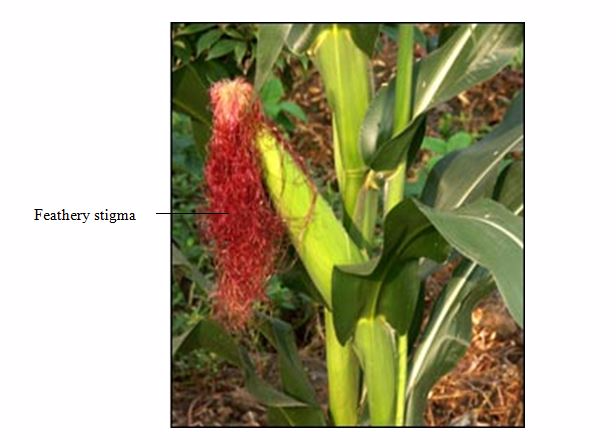
Wind-pollinated flower
Insect-pollinated flowers (bees, moths, butterflies)
Insect-pollinated flowers are also referred to as entomophilous flower. The term entomophilous is derived from the word entomophily- which means to be carried by insects. Features of insect pollinated flowers include the following:
- Large, brightly-coloured petals which attract insects. Flower structure may be adapted for one particular of insect, allowing them to land and feed.
- Usually scented; therefore they attract insects to the flower.
- Nectarines which contain nectar, for example, mango flowers have nectarines from which bees collect nectar for making honey, and while doing so transfer the pollen. The insects are guided to the nectarines by the nectar guides.
- Sticky stigma that insects come into contact with and deposit pollen while collecting nectar. The pollen grains picked by insects from other flowers stick onto the stigma.
- The stigma and anthers are held firmly in position within the flower. This ensures that when an insect lands on a flower, the stigma is not broken. The stigma and anthers are located inside the flower where pollinators are more likely to pick up pollen.
- The anthers are small in size and produce few but large pollen grains.
- The pollen grains are fairly large, heavy, sticky and with small spines. This enables them to adhere to bodies of pollinators (insects or birds).

A bee collects pollen on its body as it feeds
Flower pollinated by birds:Birds pollinate flowers when they search for nectar. Birds such as sunbirds have long slender and slightly curved beaks that they use to probe into the flower. Pollen grains stick on the beak. The pollen grains are deposited on the stigma of another flower of the same species by the bird as the bird feeds.

A bird feeding on nectar
Fertilization
The Concept of Fertilization
Explain the concept of fertilization
Fertilisation is the union of the male and female gametes to form a zygote. Pollen must fertilise an ovule to produce a viable seed. Fertilisation starts when a pollen grain lands on the stigma. Only after pollination, when pollen has landed on the stigma of a suitable flower of the same species, can a chain of events happen that ends in the making of seeds.
After a male's pollen grains have landed on the stigma during fertilization, pollen tubes develop within the style, burrowing down to the ovary, where the sperm fertilizes an ovum (an egg cell), in the ovule. A pollen tube emerges from the grain, its growth being controlled by the tube nucleus at the tip of the tube. It may grow downwards in response to chemicals made by the ovary (a response known as chemotropism).
In a process called fertilisation, the two gametes join and their chromosomes combine, so that the fertilised cell contains a normal complement of chromosomes, with some from each parent flower. The fertilised ovule goes on to form a seed, which contains a food store and an embryo that will later grow into a new plant. The ovary develops into a fruit to protect the seed. Some flowers, such as avocados, only have one ovule in their ovary, so their fruit only has one seed. Many flowers have lots of ovules in their ovary, so their fruit contains many seeds.
There are 2 types of seeds. Some are endospermic while others are non-endospermic. In endospermic seeds the food reserve is the endosperm, which is outside the plant embryo. Examples of this type of seed are maize and wheat. Non-endospermic seeds have food reserve within the cotyledon(s) of the plant embryo. This occurs in broad beans.
Process of Fertilization in Flowering Plants
Explain process of fertilization in flowering plants
During the growth and extension of the tube, thegenerative nucleus, behind the tube nucleus, divides by mitosis to produce2 male haploid sperm nuclei. The pollen tube enters the ovule through the micropyle and penetrates the embryo sac wall. Then, the tip of the tube bursts open, the tube nucleus disintegrates, creating a passage for the male nuclei and what follows is calleddouble fertilisation
- 1 male gamete fuses with the egg cell to produce adiploid zygote which undergoes mitosis to form a diploid embryo.
- 1 male gamete fuses with both the polar nuclei to produce thetriploid primary endosperm nucleus. The triploid nucleus undergoes mitosis to form the endosperm. The endosperm stores food materials that the embryo utilizes for growth and during germination.
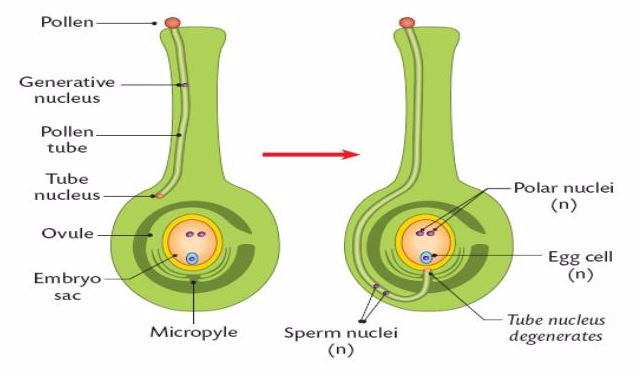
The process of fertilisation
Immediately after fertilization the ovule becomes the seed and the ovary becomes the fruit.
This is what happens:
- The zygote divides many times by mitosis to produce anembryo. It differentiates to become aplumule(young shoot),radicle(young root) and either 1 or 2cotyledons(seed leaves). It is attached to the wall of the embryo sac by a suspensor.
- The primary endosperm nucleus divides many times by mitosis to produceendosperm tissue. In some seeds this endosperm is a food store for later use by the seed. In others it may gradually disappear as the cotyledons develop.
- To accommodate all this growth the embryo sac expands and the nucellus is crushed out of existence, giving its nutrients to the embryo and endosperm.
- The integuments surrounding the embryo sac become the tough and protectivetesta (seed coat). The micropyle remains though so that oxygen and water can be taken in during seed germination.
- The water content of the seed decreases drastically so the seed is prepared for dormancy.
- The ovary wall becomes thepericarp- the fruit wall, the whole ovary now being the fruit. The function of the fruit is to protect the seeds and to aid in their dispersal, e.g. by an animal. That is why they can be brightly coloured and sweet; animals will eat them and scatter the seeds either at the time of eating or when they are passed out of the gut in defecation, unharmed.
A detailed account of what happens after fertilisation is given below:
- Formation of the testa:The testa is also referred to as the seed coat. The two integuments of the embryo sac fuse to form one seed coat. The seed coat thickens and hardens. Sometimes the outer integument forms the hard thick testa while the inner integument remains thin and transparent. The thin transparent inner integument is referred to as the tegmen.The testa protects the seed against dehydration, physical damage and invasion by microorganisms. The microphyle permits oxygen and water to enter the seed during germination. The hilum is a scar on the testa that marks the point of attachment to the fruit.
- The formation of the embryo:The egg cell nucleus fuses with the male nucleus to form a zygote. The zygote undergoes mitosis to form the embryo. An embryo is a rudimentary plant comprising the plumule, radicle and cotyledons.
- Formation of the pericarp:The ovary wall becomes thick and swells up with food substances. The pericarp develops from the ovary wall. The pericarp is often the edible layer in fruits. In mature fruit it may dry up or remain fleshy.
- Disintegration of the floral parts:The sepals, petals, stigma and style wither, dry up and fall off. In some cases, some of the floral parts may become fleshy and form part of the fruit. The fruit retains scars at the points of attachment to the pedicel and style.
Reproduction in Mammals
The Male and Female Reproductive Systems
Describe the male and female reproductive systems
Female Reproductive System
In humans, like animals, female reproductive system is composed of:
- Ovaries: Ovary is situated near each kidney. Ovary produces ova, estrogen and progesterone as female sex hormones.
- Fallopian tube: It is also known as egg tube/oviduct, it is a funnel shaped opening. Fertilization normally takes place within this tube.
- Uterus:The two fallopian tubes unite to form an expanded tubular organ called uterus womb. It is there that fertilized ova implant and develop into an embryo. N.B. Placenta is formed as an embryo develops, so as to allow penetration of nutrients, gases (oxygen and carbon dioxide) and waste products of metabolism An embryo receives nutrient and oxygen gases from maternal blood circulation and give out waste product through placenta into maternal blood system.
- Vagina: This is the posterior part of the female reproductive duct connecting the uterus with the exterior. It is in this region that sperms are deposited. N.B. Placenta with an endocrine at the last period of pregnancy, it secretes progesterone like ovaries, which prevent production of ova and contractions of the uterine walls.
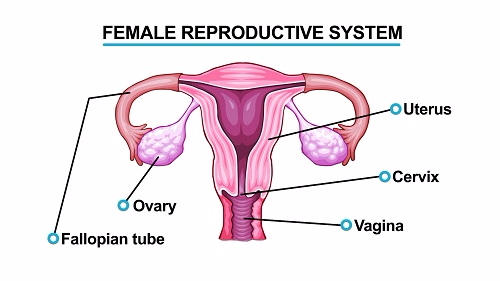
Male Reproductive System
The male mammal reproductive system is composed of:
- Testicles: These are situated in a pouch of skin called scrotum. They produce sperms as endocrine gland it produces secretes male sex hormone called testosterone. Testosterone influences male secondary characteristics during puberty in males.
- Sperm duct: It Is attached to each testicle, it acts as a temporary store for sperms. Each epididymis leads into a duct called sperm duct or vas di deferens.
- Vas deferens: Is the structure, which carries sperms away from the epididymis to penis
- Seminal vesicles and prostate glands:These are situated just below the urinary bladder and two structures called seminal vesicles. Each seminal vesicle has a tube which leads to the sperm duct. Around the junction of urinary bladder and urethra is a gland called prostate gland

Gamete Formation and Fertilization
The Process of Gamete Formation in Mammals
Outline the process of gamete formation in mammals
Gamete formation: Puberty
On average, female attain puberty (Sexual Maturity) when they are 14 years old and male when they are 16 years old. In both sexes, attainment of puberty is accompanied by certain behavioral changes as well as development of certain structures.
Those changes are known as secondary sexual characteristics.
NB: Puberty can be defined as the period when male/female changes from childhood to adulthood. These changes are influenced by sex hormones that are testosterone in males, progesterone and estrogen in females.
Secondary characteristics in males:
- Hairs on their chins and pubic region
- Shoulders widen
- Voice deepens
- Pay more attention to female sex
Secondary characteristics in females:
- Enlargement of the mammary gland and hips
- Deposition of fat which gives them more round appearance
- Development of pubic hair
- Menstruation cycle
- Pay more attention to males (young men)
NB: At puberty sex organs become fully functional in males and females.
Gamete formation:During puberty stage is when both males and females are able to produce fertile cells which united (of male and female) can cause pregnancy.
It is believed that female gametes are produced before puberty but after puberty is when they are fully matured and fertile while male gamete at large are produced during and after puberty that is when can cause pregnancy when united with female gamete.
The Processes of Ovulation and Menstruation
Explain the processes of ovulation and menstruation
Ovulation: It refers to the release of ova/ovum from ovaries to the uterus. It is expected to occur at the middle of the menstruation cycle.
Menstruation Cycle: This can be defined as the period between one and next menstrual cycle (28 days)
Menstruation: This is the discharge of mucus, epithelial cells and blood through vagina (3-5 days)
NB: The menstruation and liberation of ova every 28 days alternates between the two ovaries whereby in humans is called menstrual cycle and in non-human mammals is called oestrus cycle.
The Process of Fertilization Pregnancy and Child Birth
Explain the process of fertilization pregnancy and child birth
The Menstrual Cycle
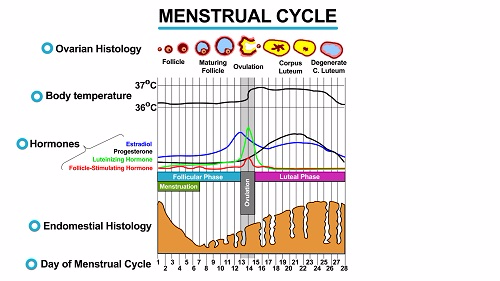
At the beginning of the cycle, the menstruation can take place between 3-5 or 7th day from the first day. At this period the secretion of female sex hormones are very low but increase after menstruation stops.
After menstruation oestrogen secretion increases, follicle stimulating hormone secreted to encourage production of ovarian follicle.
Luteinizing hormone is for maturation and ovulation of follicle while oestrogen prepares (thickening) the uterine for implantation when fertilization takes place.
At the 14th (middle) day is when ovulation can take place and secretion of progesterone increases so as to thicken the uterine wall ready for pregnancy.
NB: If no fertilization occurs, the cycle starts again.
Placenta:This is the portion of uterus, which is invaded by the villi and the thickened portion of the chorion. The chorion like amnion is a thin membrane but it has a thick portion called villi, finger-like projection.
Umbilical Cord
- It connects the developing embryo to placenta to the maternal blood system
- It carries two arteries and a vein of blood circulation of an embryo
- AN embryo uses umbilical cord for gas exchange, receiving nutrients and removal of waste products via placenta into maternal blood system
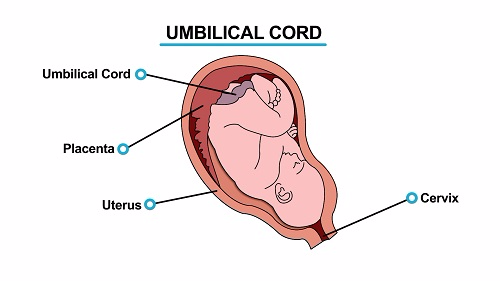
Birth
- It starts by a sudden fall in the level of oestrogen and progesterone resulting in periodic contractions of muscular walls of the uterus which cause pains called labour pains
- Under the influence of hormones a child is given out through vagina
Copulation
- When a male is sexually stimulated, the spongy penis is filled with blood and becomes erect. The erect penis is inserted into the vagina and moved back and forth, this movement stimulates sense organs in the penis and ejaculation occurs.
- Ejaculation refers to the release of sperm into the vagina; it can cause pregnancy when the fertile sperm unites with fertile ova.
Fertilization:It can be defined as the process of uniting male and female gametes to form a zygote. The sperms remain alive for up to 48 hours while ova remains alive for up to 36 hours.
Pregnancy:It refers to the situation when a female conceives. That is fertilization takes place to form zygote. Soon after zygote is formed its cell starts to divide into many cells called embryo. It takes 3-5 days for the zygote to reach to uterus for implantation.
Implantation:
- Refers to the process whereby an embryo attaches itself to the uterine wall
- It takes 3 – 5 days to implant fully
- After implantation envelope is formed, the outer chorion, inner amnion
- Between these membranes of envelop there are fluids called chorionic fluids and amniotic fluids respectively, both fluids act as shock absorbers, protecting embryo from physical damage
Factors Which May Hinder Fertilization
Outline factors which may hinder fertilization
A normal couple that is trying to start a family will usually be successful after a few months. However, at least one in ten couples do not conceive after a year or more of trying.
There are many reasons why couples can’t produce children, some of them are:
- Ova are not released in normal monthly cycle
- The fallopian tubes may be blocked/twisted
- The women may make antibodies that destroy the sperm
- The vas deferens may be blocked
- A high proportion of the sperm produced are abnormal
- Very few sperms are produced in one ejaculation
Ways of overcoming these problems
- In – Vitro Fertilization (IVF)
- Fertility Drugs
- Artificial Insemination
The Concept of Artificial Insemination and its Importance
Explain the concept of artificial insemination and its importance
Artificial insemination, also known as AI, is a procedure used to treatinfertilitythat involves direct insertion of semen into a woman's womb. It is a process originally used on livestock that has been adapted for human use. In human use, the sperm could originate from the woman's male partner, unless the male is infertile or there is no male partner (i.e. single woman or woman in same sex relationship).
The most commonly used method of artificial insemination, is IUI (Intrauterine Insemination), as it has the best success rate. Other types of AI are:
- IUTPI (Intrauterine tuboperitoneal insemination
- ICI (Intracervical insemination)
- ITI (Intratubal insemination)
Artificial insemination is beneficial to couples or individuals in many circumstances. For example a couple may be producing healthy sperm and eggs but not necessarily be able to have intercourse (maybe due to a medical condition). Some other scenarios where artificial insemination could be beneficial are listed below.
- A woman may want to raise a child alone - in this case she would request a sperm donor to be artificially inseminated.
- The female may be infertile due tocervical factor infertility- the cervix is supposed to produce a mucus that helps sperm travel to the womb. With cervical factor infertility, the cervix is either not producing enough of this mucus, or it is producing mucus containing sperm killing substances.
- The woman may be sufferingEndometriosis- this is when cells from the womb lining start to grow in places they should not within the woman's reproductive system e.g. ovaries or fallopian tubes. One of the possible results of this condition is infertility. Artificial insemination can be successful in mild to moderate cases of this.
- The female could have semen allergy - this is rare but can still happen, due to certain proteins in the sperm the woman may suffer an allergic reaction when the sperm makes contact. With IUI most of the proteins would be removed before sperm insertion.
- The male is unable to produce enough sperm for successful fertilization.
- The man is impotent(erectile dysfunction)- and would therefore be unable to perform sexual intercourse.
- The male could be infertile as a result of a medical treatment - some treatments carry the risk of infertility e.g.radiotherapy. Before the treatment the male would have been given the chance to freeze some of his sperm.
- The couple could be in same sex relationship - two women who want to raise a child together would use sperm from a donor, which one of the women would receive via artificial insemination.
- Reason for infertility cannot be determined - IUI may be recommended to a couple that cannot conceive even if no underlying reason for the infertility can be identified.
Multiple Pregnancies
The Meaning of Multiple Pregnancies
Give the meaning of multiple pregnancies
Multiple pregnancy refers to a situation when more than one ovum is released into the reproductive tract of the female. On this occasion it is possible for more than one ovum to be fertilized, consequently several viable embryos may enter the uterus where they are implanted and developed.
The Causes of Multiple Pregnancies
Explain the causes of multiple pregnancies
Multiple pregnancies may occur naturally or arise as a result of reproductive technology involving fertility drug or during an IVF program.
Causes of Multiple Pregnancy Include:
- More than one ovum released into the reproductive track
- One fertilized ovum splitting up into more than one embryo resulting to twins
Difference between Identical Twins and Fraternal Twins
Differentiate between identical twins and fraternal twins
Identical Twins:These are fully identical since they come from a single fertilized ovum, which has split to give two or four embryos and developing to give babies. They have the same sex and appearance.
Fraternal Twins:Resulting when more than one ovum (ova) are released at a time and are fertilized. They may have the same sex but not identical at all.
Disorders of Reproductive System
Types of Disorders of Human Reproductive System
Mention types of disorders of human reproductive system
Reproductive system is the one dealing with the birth of a child. We have two types of reproductive systems, which are male reproductive system and female reproductive system. The main function of reproductive system is to fuse the gamete causing fertilization. Conserving the baby in a mother’s womb till the day of bearing a child. Also is the one providing birth/bearing of a child.
There are many disorders that affect the reproductive system. These problems may be found in both male and female reproductive systems. Disorders affecting male reproductive system are Impotence, Premature Ejaculation, Inflammation and Autoimmunity. Female disorders of the reproductive system are Damage to the Oviducts (inflammation), Pelvic Inflammatory Diseases (PID), Congenital Malformation and Functional Disorder.
The Causes and Effects of the Reproductive System Disorders
Explain the causes and effects of the reproductive system disorders
Male reproductive system disorders
Impotence
This is the inability to achieve or maintain an erection of the penis. A male could not erect the penis even though he will touch the sex organs.
Causes of Impotence
- Impotence is usually psychological disturbance. It may occur any time during the life time of a male
- Strong alcohol consumption and use of drugs
- Diseases also may cause impotence
Effects of Impotence
- Impotence causes failure in performing the social act, thus one cannot have children
- May cause psychological disturbances to the person
- If an impotent person in married, impotence may lead to the break of that marriage
- It may lead to the contamination of diseases such as HIV/AIDS, gonorrhea when a couple get out of marriage to get sexual satisfaction
Premature Ejaculation
Premature ejaculation is the situation where a man reaches orgasm before penetration of the penis into the female track. Before inserting penis into the female track the male ejaculated long time outside the female track.
Causes of premature ejaculation
- Fear, anxiety and sometimes is the first time to have sexual intercourse
- Psychological factors may also lead to a problem
Effects of premature ejaculation
- The person (male) fails to satisfy a woman
- May lead to the breakage of marriage when a woman finds another male for sexual satisfaction
- May cause psychological disturbances in the man’s mind
Autoimmunity
This is a situation in which antibodies are made, which attacks own sperm, thus reducing the number of sperms. It may lead to have small number of sperms in the sperm store area.
Causes of Autoimmunity:Antibodies react to one’s own sperm. It is not exactly known what causes autoimmunity.
Effects of Autoimmunity
- It causes infertility to a person
- May cause psychological effects to the person who suffering from this problem
- No more production of children
Inflammation
It is the condition in which the urethra is blocked. It allows no movement of sperm out of the penis and also the urine.
Causes of inflammation
- May be caused by swelling of the prostate gland
- Also inflammation may cause the problem
Effects of inflammation
- Inflammation may lead to sterility (infertility)
- May cause psychological problems to the person
- May cause severe pain during sexual intercourse as one/man wants to ejaculate but sperms fail to pass through urethra
DISORDERS OF THE FEMALE REPRODUCTIVE SYSTEM
DAMAGE OF THE OVIDUCTS (INFLAMMATION)
Oviduct of the female may be blocked and causes the female organs to do fertilization of an ovum
Causes of damages to the Oviduct (inflammation):It may be caused by the infections due to different diseases. The infections may cause scarring, thus leading to partial or complete blockage of the oviduct.
Effects of damage to the Oviduct (Inflammation):It causes infertility to the female. A female may not have the ability to carry/conceive a child due to failure of fertilization of an egg in the fallopian tube.
PELVIC INFLAMMATORY DISORDER (PID)
This is the pelvic infection caused by bacteria.This condition causes damage to the oviducts.It occurs commonly to women with many sexual partners and women who use the coil contraceptive method
Effects of PID:The condition may lead to infertility. A woman may fail to bear a child and if she does so the child will not be normal
CONGENITAL MALFORMATION
Some women are born with blocked oviduct or with no uterus (it mostly happens in very few cases)
Causes of malformation:This is a woman born with disorder caused by problems in the reproductive system
FUNCTIONAL DISORDERS
This is a condition in which a woman fails/unable to experience sexual pleasure during the sexual act
Causes of functional disorders
- The cause may be psychological
- Also may be biological one
Effects of functional disorders
- May cause someone to stay away not conducting sexual intercourse
- May lead to end in marriage
Possible Remedies of Reproductive System Disorder
Suggest possible remedies of reproductive system disorder
Treatment of Impotence
- If the causes of impotence are psychological, counseling may help to cure it
- If the cause is biological, one has to attend hospital for medical check up
Treatment of premature ejaculation
- Counseling is the most effective way to be adopted to treat the problem
- Medical treatment may be applied to stop the problem
Treatment of Autoimmunity
This disorder is more difficult to treat
Treatment of inflammation
One/man should have to seek medical advice or intervention
Treatment of damage to the Oviduct (Inflammation)
Surgery is the most effective way of treating this problem.
Treatment of PID
- If a woman feels she has PID she should have to go to the hospital for the right treatment
- Abstaining from many sexual partners so as to overcome more infections/problem
Treatmentof functional disorders
- Counseling is the most effective way that may be used to help the patient regain their confidence
- Patients may go to the hospital for further checks and treatment
Complication of the Reproductive System
Types of Complications of the Reproductive Systems
Mention types of complications of the reproductive systems
Most women give birth normally and perfectly but some problems can and do occur in their reproductive system and causes effects to the newly formed embryo.The problems/complications are abortion/miscarriage, ectopic pregnancy and still births also breech birth.
- Miscarriage:This is the loss of a developing embryo before six months are over. Medically, miscarriage is considered as the natural abortion. It may result from foetus not being fully developed, failure of the embryo to implant properly or due to deformed embryo.
- Ectopic Pregnancy:Occasionally the fertilized ovum fails to reach the uterus and instead implants else where in the reproductive track. For example it can be implanted in the fallopian tube instead of uterus. This situation is known as ectopic pregnancy.Only 1 out of 50,000 ectopic pregnancies may be delivered safely.
- Abortion:Refers to the premature termination of pregnancy. Abortion may occur naturally (miscarriage) or be induced.Induced Abortionis the abortion that is deliberately brought out for medical reasons.Spontaneous Abortiois the kind of abortion that occurs without humans or medical intervention. That is not induced in any way. It is also referred to as miscarriage.
- Breech Birth:This is the situation where a baby is born feet or buttocks first. In such cases, duration of delivery is critical, too fast delivery may result in damage and too long delivery may cause oxygen deprivation and if left for a longtime may result to death of the baby.Sometimes it becomes necessary to remove the baby by other means such as forceps (surgical tongs) or Caesarian (C) section
- Caesarian Delivery:This is the removal of the baby from the uterus using surgical means through making an incision in the abdominal and uterine wall. Caesarian delivery can be done when either the baby is too big to pass the female reproductive structures or the mother’s reproductive structures are too small.
Other complications that occasionally arise during childbirth and generally require management by an obstetrician may be described as follows:
- Non-progression of labour (long-term contractions without adequate cervical dilation) is generally treated with cervical prostaglandin gel or intravenous synthetic oxytocin preparations. If this is ineffective Caesarian section may be necessary.
- Fetal distress is the development of signs of distress by the child. These may include rising or decreasing heartbeat (monitored on cardiotocography). Shedding of meconium in the amniotic fluid and other signs.
- Non-progression of expulsion (the head or presenting parts are not delivered despite adequate contractions); this can require interventions such as vacuum extraction forceps extraction and Caesarian section.In the past a great many women died during or shortly after childbirth but modern medical techniques available in industrialized countries have greatly reduced this totally.
- Unanticipated heavy bleedingduring or after childbirth is potentially lethal n places without immediate access to high-level emergency care. Heavy blood loss leads to hypovolemic shock, insufficient perfusion of vital organs and death if not rapidly treated by stemming the blood loss and blood transfusion.
Causes of Complications of the Reproductive System
Outline causes of complications of the reproductive system
Other complications that occasionally arise during childbirth and generally require management by an obstetrician may be described as follows:
- Non-progression of labour (long-term contractions without adequate cervical dilation) is generally treated with cervical prostaglandin gel or intravenous synthetic oxytocin preparations. If this is ineffective Caesarian section may be necessary.
- Fetal distress is the development of signs of distress by the child. These may include rising or decreasing heartbeat (monitored on cardiotocography). Shedding of meconium in the amniotic fluid and other signs.
- Non-progression of expulsion (the head or presenting parts are not delivered despite adequate contractions); this can require interventions such as vacuum extraction forceps extraction and Caesarian section.In the past a great many women died during or shortly after childbirth but modern medical techniques available in industrialized countries have greatly reduced this totally.
- Unanticipated heavy bleedingduring or after childbirth is potentially lethal n places without immediate access to high-level emergency care. Heavy blood loss leads to hypovolemic shock, insufficient perfusion of vital organs and death if not rapidly treated by stemming the blood loss and blood transfusion.
Ways to Minimize the Occurrence of Complications and Disorders of the Reproductive System
Suggest ways to minimize the occurrence of complications and disorders of the reproductive system
The following are the way of minimizing occurrence of complications and disorders of the reproductive system.
- Stop/minimizing amount of alcohol that we take/drink may keep us away from impotence and other infections that may lead to disorders in reproductive systems
- Practicing different duties/activities and participating in exercises also sports and games helps to reduce psychological problems which may lead to disorders in the reproductive system
- Medical check up between the partners who want to get married to know their Rhesus factors, blood groups, infections and HIV/AIDS in order to minimize the death or miscarriage during pregnancy
- Getting early treatment of any infections like gonorrhea, syphilis, bilharziasis, which may cause damage to the fallopian tubes and urethra in male and female.
Sexuality and Sexual Health and Responsible Sexual Behaviour
The Concept of Sexuality
Explain the concept of sexuality
Sexuality includes fondness or readiness for or interest in a sexual activity.
Sexuality is the function of whole personality begins at birth and end at death it includes:
- How you feel about yourself as a person
- How you feel being a man or woman
- How you get along with member of the same or opposite sex
- It also includes genital and reproductive processes such as intercourse and child bearing
Social Cultural Factors Influencing Sexual Behaviour in Different Age Groups of People
Mention social cultural factors influencing sexual behaviour in different age groups of people
Sexual Behaviour in Children
Factors influence sexual behavior in Children:
- Start at infantry when children shown their own bodies
- Also sexuality is shown at early age (play age)
- Children also do and learn from their fellow children on different sexual matters
- Education – in school and community
- Initiation rites
- Religious beliefs
- Mass Media
- Economic status – both poor and rich
Sexual Behaviour in Adolescents
Factors influence sexual behaviour in adolescents:
- Early marriage
- Social pressure (tradition of being independent)
- Drug addiction – it can stimulate or depress the sexual practice
- Peer pressure
- Education – school and community
- Moral decay
- Marriage breakdown and problems
- Poverty
- Mass Media
- Lack of proper guidance and counseling
Difference Between Responsible and Irresponsible Sexual Behaviour and Their Impact on Oneself Family and Community
Differentiate responsible from irresponsible sexual behaviour and their impact on oneself family and community
Responsible sexual behaviours are the behaviours, which are acceptable in the societies to elicit or trigger sexual activity like marriage.
Irresponsible sexual behaviors are those behaviours of an individual, which are not acceptable by family as well as societies, example use of alcohol and drugs (drug addiction) and prostitution to trigger sexual activities.
Effects of irresponsible Sexual Behaviour
To an individual:
- Becoming pregnant at a tender age, thus losing the opportunity of being officially married or continuing with studies
- Being in danger of contracting fatal venereal disease such as syphilis, HIV/AIDS, gonorrhea etc.
- It may lead to death, when an individual tries to abort an unwanted pregnancy
- Getting a responsibility of caring for a family at an early age
- It can degrade the personality of a person. For example prostitutes or rapists have no place to put their faces in some societies
To family
- Breakage of marriage
- Lead to conflict in the family or marriage
- Loss of particular relative if he/she contracts disease like HIV/AIDS
Ways of Eradicating Irresponsible Sexual Behaviours/Practices in the Family and Community
Suggest ways of eradicating irresponsible sexual behaviours/ practices in the family and community
There are several measures that can be taken to eradicate irresponsible sexual behaviours in the family and community. The measures include the following:
- Old children should not sleep with young children on the same bed without strict follow-up by the parents/guardians.
- Keeping out of all situations culminating to sexual arousal such as watching pornographic movies, alcoholism, meeting in isolated places, attending night clubs and accompanying ill groups of people like homosexuals, harlots, and rapists.
- Adults, guardians, parents, and teachers should talk openly to children about relationships and sexual-education matters to make them informed about the aftermath of irresponsible sexual behaviours.
- Close supervision and guidance of children
- Getting involved in age-appropriate activities (for example, sports, boys/girls clubs, after-school activities, and craft activities) to help keep one’s minds out of sexual mood and desires.
- Protection for children from scary or traumatic events, including media coverage of such events as wars, bombings, or shootings; and
- Closely observing what your child watches on television and in the movies or is exposed to in music and on the Internet.
- Following religious teachings on sexuality.
Appropriate Life Skills Required to Cope with Adolescent Sexuality and Sexual Behaviour
Mention appropriate life skills required to cope with adolescent sexuality and sexual behaviour
Life skills are behaviours that enable individuals to adapt to and deal effectively with the demands and challenges of life. There are many such skills, but core life skills include the ability to:
- make decisions, solve problems, and think critically and creatively;
- clarify and analyze values;
- communicate ( including listen, build empathy, be assertive, and negotiate);
- cope with emotions and stress; and
- feel empathy (understand and care about other peoples’ needs, desires and feelings) with others and be self-aware.
Some life skills required to cope with adolescent sexuality and sexual behaviour include the following:
- Educating youth about health-related issues, such as alcohol, tobacco, and other drug use; nutrition; reproductive health; and preventing HIV/AIDS and other sexually transmitted infections (STIs). Life skills education can also be effective in preventing school dropout and violence among young people.
- Referring young women to age-appropriate reproductive health services.
- Promoting youth's livelihood through vocational training, recreation, etc.
- Mobilizing and empowering individuals, families, and communities in order to reach, influence, and involve everyone to become a part of the solution.
- Parents and teachers strictly supervising teenagers at home and school, respectively.
- Adults and parents inculcating good moral behaviours to adolescents by serving as good examples for them to follow.
Family Planning and Contraception
The Concept of Family Planning and Contraception
Explain the concept of family planning and contraception
Family planning is a decision made by a person freely on how many children he or se may want to have and when she or he wants to stop.
Contraception refers to prevention of conception that is prevention or preventing the fusion of the male gamete with the female gamete. Birth control is broad it includes measures taken to prevent birth after fertilization.
There are two methods used namely Artificial family planning methods and Natural family planning menthods.
- Artificial Family Planning Methodsincludes sterilization, oral contraceptives, intra-uterine devices, Norplant, diaphragm and condoms
- Natural Family Planning Methodsincludes rhythm, the basal body temperature and withdrawal (coitus interrupt)
Social Practices which Enhance Family Planning
State social practices which enhance family planning
Social cultural practices, which enhance family planning, include the natural methods of family planning, which are:
Abstinence
This refers to the avoidance of sexual intercourse or can be defined as refusal by sexually active male and female to have sexual intercourse.
Advantage of Abstinence
- It is the most effective method of preventing conception
- The approximated rate of failure of this method is zero percent
Disadvantages of Abstinence
It is said to be unrealistic for many to practice this method
Rhythm Method (Calendar Method)
This is modified from abstinence. N intercourse is done during the fertile period. These days can be counted or identified by counting the days between menstrual period and also by observing certain associated physical changes such as small changes in body temperature. A woman may also keep a written chart of her menstrual cycle for certain months and is taught how to determine the number of days each month when sexual intercourse must be avoided. Total abstinence is about 7 days in a month.
Advantages of the Rhythm Method
- The method is said to be natural and widely acceptable
- It has no cost
- It is said to be 77-87% effective
Disadvantages of Rhythm Method
- The approximate failure rate is 20%
- It requires good knowledge and good record keeping
- It also requires a period of abstinence
- Irregularity of the menstrual period (cycle)
Temperature Method
This method is based on the changes of a woman’s body’s temperature due to her menstrual cycle. The temperature is said to drop during the menstrual period and remains low until the release of an ovum. A rise in temperature is noted at ovulation and sexual intercourse should be avoided at this time if conception is not intended.
Advantages of the Temperature Method
- The method is said to be 76-80% effective
- It costs nothing
- It does not require fitting and regular checkups
Disadvantages of the Temperature Method
- The approximate failure is said to be 20-24%
- Sperms released to a female tract a few day before ovulation may survive until ovulation
- Irregularity of the ovulation may cause fluctuation of temperature
Billing Method (Ovulation Method)
This method is based on the fact that the secretion from the female tract changes noticeably during the course of her menstrual cycle. The appearance of clear thin mucus in female tract secretions at ovulation is noted and sexual intercourse is avoided during these times.
Advantages of Billing Method
- It is said to be 76-80% effective
- It costs nothing (it is cheap)
- It does not require fitting and regular check ups
Disadvantages of Billing Method
Regularity of ovulation may cause fluctuation of temperature
Coitus Interruption (withdrawal)
Coitus interruption or withdrawal is another natural method of birth control in which a male withdraws his penis from a female tract before ejaculation. This method is one of the oldest methods of birth control. Coitus interruption requires unusual degree of will power.
Advantages of Withdrawal
- The method is costless
- It is reliable for 76-80% when practiced
Disadvantages of Withdrawal
- The method requires some degree of will power
- It has a high failure rate in case fluid released from the penis just before ejaculation may contain viable sperms
- Sperms may leak from penis before is withdrawal even without ejaculation
Artificial Methods of birth control
Barrier Methods
These methods prevent sperms from entering the female tract. These methods include:
Condom:This is a thin rubber sheath, which prevents sperms from entering into the female tract. Male condom is worn over an erect penis during intercourse and prevents sperms from being released into the female tract that way preventing union of sperm and ovum.
Advantages of Condoms
- Condoms are said to be 85% to 93% reliable when used properly (handled with care)
- They may help prevention of sexually transmitted diseases such as fungal infection
- They are cheap and easily and obtained
Disadvantages of Condoms
- Condoms can tear and leak. In such cases they become useless
- A condom may slip off the penis after climax
- Condoms may disrupt the act of love making (reduce sensation)
Female Condoms
Female condoms are equivalent to male condoms in that:
- It is a thin rubber tube with a close end which fits inside the female tract
- Female condoms are relatively new, so not much is known about them. They give a woman some control and are said to have the advantages as those f the male condoms
Diaphragm
This is another barrier method that prevents entering of sperms into the female tract.A diaphragm is a flexible rubber, which fits over the cervix and prevents entry of sperm to uterus. It is applied with contraceptive jelly (cream) or spermicidal chemicals, which kill sperms. A doctor must prescribe this method.
Advantages of Diaphragm
- The method is said to be cheap
- It can be inserted a few hours before sexual act
Disadvantages of Diaphragm
- The diaphragm must be fitted by a doctor and training is required for the woman to fit it
- It disrupts spontaneity
- It occasionally causes pain in the abdomen
- It needs check up after every six (6) months
- It should be left in place six hours after intercourse
Spermicidal
These are chemicals, which kills sperms. Spermicidal foam, or spermicidal jelly is placed in an applicator, which is inserted and emptied into the female tract just before sexual intercourse. These kill sperm and block cervix.
Advantages of Spermicidal
- It is cheap
- It is effective for about an hour
Disadvantages of Spermicidal
- It is messy
- It has a high failure rate if used on its own
The pill
This is one of the most widely used contraceptive methods.The pill is an oral contraceptive by synthetic oestrogen and progesterone taken daily by the female.It function by suppressing the normal release of gonadotropins from the pituitary. These synthetic hormones prevent the ovulation process, thus hindering fertilization.
Advantages of the pill
- The pill is said to be very effective i.e. it is about 98% successful
- A woman has control over the method
- It has no interference with sexual intercourse
Disadvantages of the pill
- It is not suitable for all women. There may be increased risk of blood clotting in some women
- It is not recommended for older women or women who smoke
- Short term side effects of the pill include nausea, weight gain, tissue swelling, fluid retention and minor headaches
The Importance of Male Involvement in Family Planning
Outline the importance of male involvement in family planning
People go for family planning or control for a number of reasons. Among these are:
- To ensure both partners are healthy and observe medical measures that are advised, giving enough time for a mother’s full recovery after giving birth
- Ability to cater for the needs of many children
- Couples decide to practice child spacing so that they can cater for their needs
- Helps to improve the health of a mother by helping women to avoid pregnancy at early age, unwanted pregnancies and to become pregnant at late age of 35 years
Importance of Family Planning and Contraception
- Some family planning methods help to prevent the transmission of HIV and sexually transmitted infections
- Family planning reduces the need for unsafe abortion
- Family planning reinforces people’s rights to determine the number and spacing of their children
- Family planning helps to build the health of a mother
- Family planning enables the couple to be able to handle the family by catering to the needs of family
Maternal and Child Care
The Concept of Maternal and Child Care
Explain the concept of maternal and child care
A pregnant mother needs a lot of care and consideration for the best of her health and that of the child. Basically there are two types of care given to pregnant mother. These are pre-natal and post-natal care. The care given before birth is called pre-natal care and the care given during birth is called natal care. But a pregnant mother also needs a care and support after birth of the child; this kind of care and support provided after birth is called post-natal care.
Maternal care during pregnancy (Pre-natal care)
Pre-natal care means before birth; therefore pre-natal care means a care given to a pregnant woman before delivery.
Things to be done by a pregnant mother
- Visit ante-natal clinic for counseling
- Maintain general body cleanliness all the time
- Have enough rest
- Wear lose-fitting dresses and low heeled shoes for comfort
- Eat well balanced diet containing all types of food
Things to be avoided by a pregnant mother
- Doing tiresome and manual work. Example lifting heavy loads
- Taking any medicine not prescribed by the doctor
- Taking drugs such as alcohol, cigarettes which could be detrimental to the unborn baby
- Tight clothes and high heeled shoes
- Avoid situations leading to chances of contracting venereal diseases such as gonorrhea, syphilis and AIDS which might affect the baby
- Avoid stressful situation
Care during natal period
Natal period is the period when the pregnant mother gives birth to the child she has been carrying in her womb for about nine months. A number of things need to be considered during natal period:
- An expectant mother needs to undergo labor under supervision of a trained nurse or trained birth attendant whenever this is possible
- If any complications occur that can not be solved by either a trained nurse or a trained birth attendant arises, an expectant mother should be referred to the health center or hospital for medical assistance
- Most births are perfectly normal but problems can and do occur. When problems arise, modern delivery facilities or techniques such as Caesarean section and vacuum extraction are used. Care should be taken not to damage any organ of the baby or the mother
- In case a newborn baby is pre-mature appropriate services should be given to it so as to help it accomplish a normal pattern of growth and development
Post-natal services to the mother and the child
These are care and services provided to the mother and the newborn child after birth. After birth a mother has another big responsibility and role of breast-feeding the child.
Also a mother should attend post-natal clinic for medical checks and immunization of the child Balanced diet should be supplied to a lactating mother so as to ensure that she gets enough nutrition for her benefit and ultimately that of the child.
Proper nutrition will help her to restore the tissue worn out during the natal period. This helps also the newborn baby to have enough milk from its mother. The health of both the mother and her child should be seriously taken care of.
Child health care
Mothers should breast-feed the child whenever possible, mother’s milk is better than any other food because of the following:
- It contains antibodies that are much needed to the child
- In case the mother has no health problems such milk is free from contamination
- Mother’s milk also contains much proteins and vitamins which are very important for the child’s growth
- Breast milk is easily digested than other milk example bottled milk. Therefore children who take milk from their mother rarely suffer from constipation
- Mother’s milk is said to contain some chemicals which help in development of the nervous system of the child
- Regular attendance of post-natal clinic for the child is very important. The child should also get immunized against different infections and diseases such as polio, measles and other diseases
- The mother should follow medical advice on how to handle the child and in case of any problems report it to the personnel concerned
Social-Cultural Factors which Affect Maternal and Child Care in the Family and Community
Mention social-cultural factors which affect material and child care in the family and community
These include the following:
- Female Genital Mutilation (FGM):This is the practice of circumcising women. It is said to have effects during childbirth. It causes women to experience pain, bleeding, and shock and may lead to infection.
- Local Belief:These are certain local beliefs and taboos such as banning women to eat certain types of foods such as protein rich foods, which could help to build their health and that of the child.
- Working especially hard work such as cultivation: Hard work may cause several problems to the pregnant woman such as miscarriage or pain.
- Alcohol Consumption during pregnancy:In most cultural practices taking alcohol is considered as a normal behaviour. But alcohol during pregnancy affects both the health of the mother and that of the child.
Appropriate Ways of Providing Maternal and Child Care for People Living with HIV/AIDS (PLWHA
Suggest appropriate ways of providing maternal and child care for people living with HIV/AIDS (PLWHA)
These include the following:
- To ensure frequent medical check up for both maternal and child
- To ensure they get well balanced diet
- Avoid sharing sharp objects like razor blades
- Counseling in order to help them deal with their feelings of loss and grief
- To avoid discrimination for people living with HIV/AIDS
- Ensure the use of polite language when providing care to them
- Wearing of gloves when cleaning their bodies and clothes
...



No comments:
Post a Comment